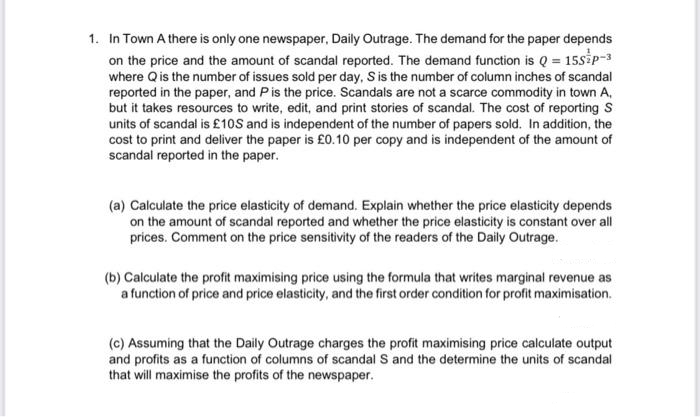1. In Town A there is only one newspaper, Daily Outrage. The demand for the paper depends on the price and the amount of scandal reported. The demand function is Q = 155 p-3 where Q is the number of issues sold per day, S is the number of column inches of scandal reported in the paper, and P is the price. Scandals are not a scarce commodity in town A, but it takes resources to write, edit, and print stories of scandal. The cost of reporting S units of scandal is £10S and is independent of the number of papers sold. In addition, the cost to print and deliver the paper is £0.10 per copy and is independent of the amount of scandal reported in the paper. (a) Calculate the price elasticity of demand. Explain whether the price elasticity depends on the amount of scandal reported and whether the price elasticity is constant over all prices. Comment on the price sensitivity of the readers of the Daily Outrage. (b) Calculate the profit maximising price using the formula that writes marginal revenue as a function of price and price elasticity, and the first order condition for profit maximisation. (c) Assuming that the Daily Outrage charges the profit maximising price calculate output and profits as a function of columns of scandal S and the determine the units of scandal that will maximise the profits of the newspaper.
1. In Town A there is only one newspaper, Daily Outrage. The demand for the paper depends on the price and the amount of scandal reported. The demand function is Q = 155 p-3 where Q is the number of issues sold per day, S is the number of column inches of scandal reported in the paper, and P is the price. Scandals are not a scarce commodity in town A, but it takes resources to write, edit, and print stories of scandal. The cost of reporting S units of scandal is £10S and is independent of the number of papers sold. In addition, the cost to print and deliver the paper is £0.10 per copy and is independent of the amount of scandal reported in the paper. (a) Calculate the price elasticity of demand. Explain whether the price elasticity depends on the amount of scandal reported and whether the price elasticity is constant over all prices. Comment on the price sensitivity of the readers of the Daily Outrage. (b) Calculate the profit maximising price using the formula that writes marginal revenue as a function of price and price elasticity, and the first order condition for profit maximisation. (c) Assuming that the Daily Outrage charges the profit maximising price calculate output and profits as a function of columns of scandal S and the determine the units of scandal that will maximise the profits of the newspaper.
Principles of Economics (MindTap Course List)
8th Edition
ISBN:9781305585126
Author:N. Gregory Mankiw
Publisher:N. Gregory Mankiw
Chapter7: Consumers, Producers, And The Efficiency Of Markets
Section: Chapter Questions
Problem 6PA
Related questions
Question

Transcribed Image Text:1. In Town A there is only one newspaper, Daily Outrage. The demand for the paper depends
on the price and the amount of scandal reported. The demand function is Q = 15SP-3
where Q is the number of issues sold per day, S is the number of column inches of scandal
reported in the paper, and P is the price. Scandals are not a scarce commodity in town A,
but it takes resources to write, edit, and print stories of scandal. The cost of reporting S
units of scandal is £10S and is independent of the number of papers sold. In addition, the
cost to print and deliver the paper is £0.10 per copy and is independent of the amount of
scandal reported in the paper.
(a) Calculate the price elasticity of demand. Explain whether the price elasticity depends
on the amount of scandal reported and whether the price elasticity is constant over all
prices. Comment on the price sensitivity of the readers of the Daily Outrage.
(b) Calculate the profit maximising price using the formula that writes marginal revenue as
a function of price and price elasticity, and the first order condition for profit maximisation.
(c) Assuming that the Daily Outrage charges the profit maximising price calculate output
and profits as a function of columns of scandal S and the determine the units of scandal
that will maximise the profits of the newspaper.
Expert Solution
This question has been solved!
Explore an expertly crafted, step-by-step solution for a thorough understanding of key concepts.
Step by step
Solved in 3 steps

Knowledge Booster
Learn more about
Need a deep-dive on the concept behind this application? Look no further. Learn more about this topic, economics and related others by exploring similar questions and additional content below.Recommended textbooks for you

Principles of Economics (MindTap Course List)
Economics
ISBN:
9781305585126
Author:
N. Gregory Mankiw
Publisher:
Cengage Learning

Principles of Microeconomics (MindTap Course List)
Economics
ISBN:
9781305971493
Author:
N. Gregory Mankiw
Publisher:
Cengage Learning

Principles of Macroeconomics (MindTap Course List)
Economics
ISBN:
9781285165912
Author:
N. Gregory Mankiw
Publisher:
Cengage Learning

Principles of Economics (MindTap Course List)
Economics
ISBN:
9781305585126
Author:
N. Gregory Mankiw
Publisher:
Cengage Learning

Principles of Microeconomics (MindTap Course List)
Economics
ISBN:
9781305971493
Author:
N. Gregory Mankiw
Publisher:
Cengage Learning

Principles of Macroeconomics (MindTap Course List)
Economics
ISBN:
9781285165912
Author:
N. Gregory Mankiw
Publisher:
Cengage Learning

Essentials of Economics (MindTap Course List)
Economics
ISBN:
9781337091992
Author:
N. Gregory Mankiw
Publisher:
Cengage Learning

Principles of Economics, 7th Edition (MindTap Cou…
Economics
ISBN:
9781285165875
Author:
N. Gregory Mankiw
Publisher:
Cengage Learning
